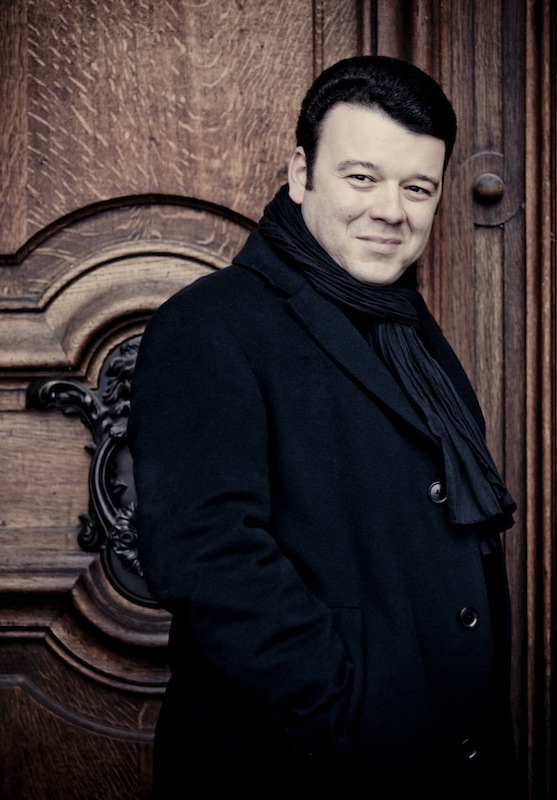Gluzman lights a Russian fire with Orpheus at Kravis Center

Vadim Gluzman performed with the Orpheus Chamber Orchestra Monday afternoon at the Kravis Center. Photo: Marco Borggreve
The Orpheus Chamber Orchestra has been a regular visitor to the Regional Arts concert series at the Kravis Center. On Monday afternoon the conductor-less ensemble, which has flourished for more than four decades, returned to West Palm Beach with one of its characteristic programs featuring a major symphony, a short American work, and a star turn by violinist Vadim Gluzman.
Orpheus is comprised of some of New York’s top freelance players. These musicians attempt to approach orchestral performance like chamber music and, most of the time, they play with precision and unanimity. The problem with some of this group’s performances and recordings is that major orchestral scores can sound cold and lacking in stylistic authority without a conductor’s shaping hand. At Monday’s concert this tendency was less evident although there were some ensemble problems with accompanying the soloist.
Mendelssohn’s Symphony No. 3 in A minor (“Scottish”) is usually played by larger orchestras. While the performance would have benefited from a bigger string section, particularly in the third movement Adagio, Orpheus managed to bring off the symphony with a fine sense of Mendelssohn’s ardent romanticism and melodic grace. The smaller string contingent allowed wind lines to emerge with greater clarity and emphasis.
There was plenty of power and thrust in the storm-tossed first movement and the Vivace ma non troppo (second movement) was equally robust. The horns were particularly firm and sonorous. A brisk tempo and clean delineation between winds and strings sped the finale along in spirited fashion. Horns and trumpets blazed splendidly in the highlands coda.
In recent seasons Orpheus has played and premiered works by contemporary composers. Replacing the originally scheduled Final Stages by Michael Hersch, the orchestra played A Canticle of Shadows by the British-born, Atlanta-based composer Richard Prior. Inspired by the wars and human tragedies in Syria, the Middle East and Ukraine, Prior’s nine-minute score for strings effectively expresses grief through alternation of a stark chorale and more expansive elegiac melody.
Whether intended or not, this work bears a strong resemblance to Barber’s Adagio for Strings. Like that iconic score, the piece has a big string climax, followed by a quiet fade out with fragments of the main thematic material. It is an attractive and highly effective creation which displayed the players’ tonal warmth and finely varied dynamics.
Tchaikovsky’s Violin Concerto in D Major is one of the most often performed showpieces in the repertoire. It can be effectively played with numerous interpretive conceptions. Last season Gil Shaham offered a freshly considered, classically based reading with the New World Symphony.
Gluzman’s performance was bathed in old- school Russian romanticism. He draws depth of tone and glowing sonority from the 1690 Leopold Auer Stradivarius, the instrument played by the virtuoso Tchaikovsky conceived the concerto for. (Auer initially rejected the concerto as unplayable but later performed the score in his own revised edition.)
Gluzman exhibited great flexibility in tempo and phrasing. His tone was alternately lean or dark and burnished. There were sudden deviations in speed and shaping of the melodies but he continually brought intense passion to the opening movement, tossing off the cadenza flawlessly.
His tempo in the Canzonetta was slower than in most performances and he really emphasized the heart on sleeve, Russian angst through heavy portamento and long-breathed phrasing. Few violinists have played the finale as fast as Gluzman and he milked the gypsy paprika of the second theme for all it was worth. The entire performance was a vivid demonstration of instrumental command and bravura. As an encore, Gluzman breezily galloped through a transcription for violin and orchestra of the Polka from Shostakovich’s Jazz Suite No. 1.
Although the small orchestral forces allowed many instrumental details that are usually obscured to come through clearly, the ensemble was not always together with Gluzman. There was some fuzzy wind intonation and the trumpets seemed to be having an off day.
Although the program listed the three movements of the Tchaikovsky concerto, not only did much of the matinee audience applaud after the first movement but many stood in ovation, thinking the concerto was over. After the performance, one audience member asked “Was the rest also by Tchaikovsky?”
The Regional Arts series at the Kravis Center in West Palm Beach continues with Stéphane Denève conducting the Philadelphia Orchestra in Shostakovich’s Symphony No. 5 and Rachmaninoff’s Piano Concerto No. 3 with soloist Denis Kozhukhin 8 p.m. February 7. kravis.org
Posted in Performances
Leave a Comment
Tue Jan 17, 2017
at 1:10 pm
No Comments